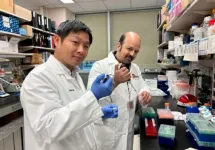High-precision blood glucose level prediction achieved by few-molecule reservoir computing
Advancement in compact AI device development employing molecular vibrations and operation verification
2024-04-26
(Press-News.org)
1. A collaborative research team from NIMS and Tokyo University of Science has successfully developed a cutting-edge artificial intelligence (AI) device that executes brain-like information processing through few-molecule reservoir computing. This innovation utilizes the molecular vibrations of a select number of organic molecules. By applying this device for the blood glucose level prediction in patients with diabetes, it has significantly outperformed existing AI devices in terms of prediction accuracy.
2. With the expansion of machine learning applications in various industries, there's an escalating demand for AI devices that are not only highly computational but also feature low-power consumption and miniaturization. Research has shifted towards physical reservoir computing, leveraging physical phenomena presented by materials and devices for neural information processing. One challenge that remains is the relatively large size of the existing materials and devices.
3. Our research has pioneered the world’s first implementation of physical reservoir computing that operates on the principle of surface-enhanced Raman scattering, harnessing the molecular vibrations of merely a few organic molecules. The information is inputted through ion-gating, which modulates the adsorption of hydrogen ions onto organic molecules (p-mercaptobenzoic acid, pMBA) by applying voltage. The changes in molecular vibrations of the pMBA molecules, which vary with hydrogen ion adsorption, serve the function of memory and nonlinear waveform transformation for calculation. This process, using a sparse assembly of pMBA molecules, has learned approximately 20 hours of a diabetic patient's blood glucose level changes and managed to predict subsequent fluctuations over the next 5 minutes with an error reduction of about 50% compared to the highest accuracy achieved by similar devices to date.
4. The outcome of this study indicates that a minimal quantity of organic molecules can effectively perform computations comparable to a computer. This technological breakthrough of conducting sophisticated information processing with minimal materials and in tiny spaces presents substantial practical benefits. It paves the way for the creation of low-power AI terminal devices that can be integrated with a variety of sensors, opening avenues for broad industrial use.
***
5. The research initiative was spearheaded by Daiki Nishioka, serving as a Trainee in Ionic Devices Group at NIMS, Research Center for Materials Nanoarchitectonics (MANA), who is also a Japan Society for the Promotion of Science (JSPS) Research Fellow at Tokyo University of Science, and Takashi Tsuchiya, Principal Researcher, and Kazuya Terabe, Group Leader, both part of Ionic Devices Group at MANA, NIMS. This project is a segment of the "Nano Materials for New Principle Devices," supervised by Yoshihiro Iwasa, and is focused on the "Creation of Ultrafast Iontronics" under the auspices of JST PRESTO (JPMJPR23H4).
6. The findings of this research was published online in the Science Advances journal at 4 a.m. Japan time on February 29, 2024.
END
[Attachments] See images for this press release:


ELSE PRESS RELEASES FROM THIS DATE:
2024-04-26
**ECCMID has now changed its name to ESCMID Global, please credit ESCMID Global Congress (formerly ECCMID, Barcelona, Spain, 27-30 April) in all future stories**
In global crises like the COVID-19 pandemic, it is vital that scientists step forward to engage with the public and help deliver medical and scientific advice in a friendly, digestible and open format. While the traditional way for scientists to do this is by responding to media requests, alternatives, including collaborating with illustrators and local communities, will be discussed in a new ...
2024-04-26
During epidemics of Ebola, COVID-19, Zika and other public health emergencies, effective communication of public health messages is crucial to control the spread of disease, maintain public trust, and encourage compliance with health measures. In a new evidence review to be given at this year’s ESCMID Global Congress (formerly ECCMID) in Barcelona, Spain (27-30 April), Dr Benjamin Djoudalbaye from the Africa Centres for Disease Control and Prevention (AFRICA CDC) in Ethiopia, will discuss the challenges and lessons learnt from public health communication strategies during multiple epidemics across ...
2024-04-26
Hospital-related infections resistant to carbapenems, considered the antibiotics of last resort for treating severe infections, remain at least 35% higher than before the pandemic.
Findings also reveal that during the pandemic, hospitals experiencing surges due to high volumes of severely ill COVID-19 patients had the greatest increases in hospital-acquired antimicrobial-resistant infections, as did larger hospitals with increased bed capacity.
**ECCMID has now changed its name to ESCMID Global, please credit ...
2024-04-26
Findings underscore need for rational antibiotic use especially during viral pandemics like COVID-19.
*ECCMID has now changed its name to ESCMID Global, please credit ESCMID Global Congress (formerly ECCMID, Barcelona, Spain, 27-30 April) in all future stories**
Antibiotic treatment of adults hospitalised with moderate COVID-19 is associated with clinical deterioration, despite the drugs being given to over 40% of patients, according to new research being presented at this year’s ESCMID Global Congress (formerly ECCMID) in Barcelona, Spain (27-30 April)
The findings underscore the need to discourage indiscriminate prescribing ...
2024-04-25
Targeting specific protein regions offers a new treatment approach in medulloblastoma
Scientists at St. Jude Children’s Research Hospital discovered a new compound that selectively targets parts of a cancer-related protein, EP300/CBP, in Group 3 medulloblastoma.
(MEMPHIS, Tenn. – April 25, 2024) Medulloblastoma (the most common malignant childhood brain tumor) is separated into four molecular groups, with Group 3 bearing the worst prognosis. By studying EP300 and CBP, critical proteins in Group 3 medulloblastoma cells, scientists at St. Jude Children’s Research Hospital designed a way to enhance anti-tumor ...
2024-04-25
INDIANAPOLIS — Indiana University School of Medicine scientists are on a mission to understand why hematopoietic stem cells, responsible for producing all types of mature blood cells, exhibit better responses in a low-oxygen environment within the bone marrow, also known as hypoxia. Their discoveries and innovative approaches could influence treatment options like bone marrow transplantation for conditions such as bone marrow failure and rare blood diseases involving gene corrected stem cells.
A new four-year, ...
2024-04-25
CV Societies Propel Plans Forward for a New American Board of Cardiovascular Medicine
Planning enters next phase as ABMS announces open comment period
WASHINGTON (April 25, 2024) – Efforts by the American College of Cardiology, American Heart Association, Heart Failure Society of America, Heart Rhythm Society and The Society for Cardiovascular Angiography & Interventions to create a new, independent American Board of Cardiovascular Medicine under the American Board of Medical Specialties (ABMS) are closer to becoming a reality with the creation of a formal Board of Directors and the announcement by the ABMS Advisory Board on Specialty Board Development of an open comment ...
2024-04-25
Hebrew SeniorLife is among the 30 US health systems nationally, and the only one in Massachusetts selected to participate in the Age-Friendly System-Wide Spread Collaborative.
This first-of-its-kind Collaborative, led by the Institute for Healthcare Improvement (IHI), will accelerate and spread the adoption of evidence-based, high-quality care for older adults across all of their sites and care settings.
The Collaborative is the latest endeavor of the Age-Friendly Health Systems initiative, which promotes four evidence-based elements of high-quality care known as ...
2024-04-25
A new tool to identify infants most at risk for severe respiratory syncytial virus (RSV) illness could aid pediatricians in prioritizing children under 1 to receive a preventive medication before RSV season (October-April), according to Vanderbilt University Medical Center (VUMC) research published in Open Forum Infectious Diseases and to be presented at the American Thoracic Society 2024 International Conference.
Study authors considered factors including birth month, birth weight and whether an infant has siblings to determine who is most at risk of severe RSV illness ...
2024-04-25
Several municipal, county, and Tribal governments and community groups based in the Reno-Sparks area are teaming up to map the hottest parts of Reno, Sparks, and adjacent portions of Washoe County. The National Oceanographic and Atmospheric Administration (NOAA) is partnering with the U.S. Departments of Health and Human Services and Housing and Urban Development to map urban heat islands.
“Urban heat islands are when urbanized areas have higher temperatures than outlying rural areas,” said Tom Albright, Nevada State Climatologist ...
LAST 30 PRESS RELEASES:
[Press-News.org] High-precision blood glucose level prediction achieved by few-molecule reservoir computing
Advancement in compact AI device development employing molecular vibrations and operation verification




